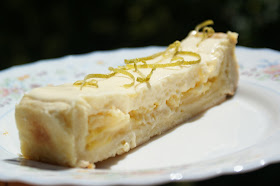For the pastry
175g/6oz plain flour
100g/3½oz cold butter,
cut into small cubes
25g/1oz icing sugar
1 free-range egg yolk
1 tbsp cold water
For the first layer
5 free-range eggs
125ml/4fl oz double
cream
225g/8oz caster sugar
4 lemons, juice and
zest
icing sugar, for
dusting
For the second layer
3 x 61 g free range
eggs
3 lemons
100 g castor sugar
2 gelatine leaves
¼ cup hot water
300 ml rich cream (45%
fat)
To make the pastry,
place the flour, butter and icing sugar into a food
processor. Pulse
briefly until the mixture resembles breadcrumbs,
then add the egg yolk
and water.
Pulse again until the
mixture sticks together in clumps then tip onto a
work surface and gather
it into a ball with your hands. Knead the
pastry just two or
three times to make it smooth. If your butter was a
bit too soft, the
pastry might be too. If so, wrap it in parchment paper
and chill for 15
minutes.
Grease a 23cm/9in
loose-bottomed, fluted tart tin.
Lay a piece of
parchment paper on the work surface. Remove the
base from the tart tin
and lay it on the paper. Using a pencil, draw a
circle onto the paper
4cm/1½in bigger than the tin base.
Dust the base of the
tin with flour. Place the pastry ball in the centre
of the tin base and
flatten it out slightly. Roll out the pastry, still on
the base, until it
meets the circle mark. As you are rolling out, turn
the pastry by turning
the paper. Gently fold the pastry surrounding
the tin base in towards
the centre.
Carefully lift the tin
base off the work surface, drop it into the tin, then
ease the pastry into
the corners and up the sides of the tin, pressing
the overhang lightly
over the rim. If the pastry has cracked at all,
simply press it
together to seal. Press the pastry into the flutes of the
tin then lightly prick
the base with a fork, but not quite all the way
through. Place the
pastry-lined tin on a baking tray, cover loosely
with cling film and
chill in the fridge for 30 minutes. Preheat the oven
to 200C/400F/Gas 6.
Remove the cling film
from the pastry case and line with foil so it supports the sides,
then fill with baking beans.
Bake blind for 12-15 minutes, until the pastry is set, then lift
out the foil and beans.
Carefully trim the
excess pastry from the sides using a sharp knife,
holding the knife at a
sharp angle and slicing away from you.
Remove the trimmings
from the sheet. Return the empty pastry case
to the oven for another
10-12 minutes or until it is pale golden and
completely dry. Set
aside to cool while you make the filling. Reduce
the oven temperature to
170C/325F/Gas 3.
For the base filling
Break the eggs into a
large bowl and whisk together
with a wire whisk. Add
the rest of the filling ingredients and whisk
again until they are
all well combined. Pour the filling mixture into a
jug, then into the
cooled baked pastry case. To prevent it spilling as it
goes in the oven, pour
in most of the filling so it almost fills the tart,
carefully sit the
baking sheet and tart on the oven shelf, then top up
with the rest of the
filling to completely fill it. Bake for about 30-35
minutes or until just
set but with a slight wobble in the centre.
Leave to cool slightly then, when the pastry
seems firm enough,
remove the tart from
the tin. The easiest way to do this is to place the
base of the tin on an
upturned can or jam jar and let the outer ring fall
to the work surface.
Allow to cool completely.
For the second layer
Separate the eggs. Finely grate the zest of lemons and then
juice them (you’ll need 100 ml strained juice). Bring a large saucepan of water
to the boil. Put the egg yolks, zest, juice and castor sugar into a large
stainless steel bowl and set this over the boiling water, then whisk until pale
and thick. Remove the bowl and set aside.
Soften the gelatine in a little cold water for 5 minutes,
then squeeze out any excess moisture and dissolve the leaves in the hot water.
Whisk this into the egg mixture and refrigerate until cold and just starting to
set.
Whish the cream until soft peaks form, then fold this
through the cold sabayon. Refrigerate until just starting to set. Whisk the egg
whites until soft peaks form (be careful not to over whip them or the texture
of the final dessert will be crumble rather than soft and light) and fold these
through too.
Spoon the mixture into the cooled tart and allow to set in
the fridge for about 3 hours.








